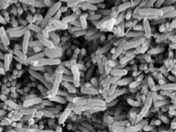|
|
April Foolery: The Smelly Microbe
![]()
 |
NAME: Aromabacter malodorens
IMAGE SIZE: 16 microns IMAGE CREDITS: Shirley Owens and Catherine McGowan, Microbe Zoo Project, Comm Tech Lab, Michigan State University. Click image to download large 640 x 480 JPEG image (approximate download times: 28.8 k = 40 sec; T1 = 11 sec.) |
Aromabacter malodorens is the bacterium that colonizes healthy human skin. This organism grows on sweat and produces butyrate and other organic acids which smell bad in high concentrations.
This past year, scientists affiliated with the International Society for Microbial Ecology created a genetically engineered strain of this microorganism that can help banish unpleasant underarm odor.
Scientists removed the butyrate synthase gene that causes one of the unpleasant odors. Scientists then inserted the DNA from an Asian Musk Deer that encodes muskolic acid. Muskolic acid is the compound that gives musk oil its characteristic smell.
In preliminary studies, this new strain of Aromabacter malodorens survives well on the human skin. Scientists are now working on ways for the genetically engineered bacteria to out compete native populations of foul-smelling bacteria.
The ISME plans to market an underarm deodorant containing these new bacteria and license this technology to other deodorant manufacturers. Because the deodorant is self-replicating, it requires only monthly application.
If this microorganism sells well, the ISME plans to genetically engineer a mint-flavored bacterium for the mouth.
If you would like more information or would like to participate in a deodorant trial, please email Dr. Gutensmell.
This microbe was written for the month of April. Happy April Fool's Day.
![]()
Glossary
bacterium - (plural = bacteria) - a simple, small microbe lacking a nucleus. Bacteria are also called prokaryotes or monerans. Most bacteria are unicellular, containing only a single cell. Sometimes bacteria appear multicellular, living together in groups of cells. Bacteria comprise two of the three domains of life, the Eubacteria and the Archaea.
This page last updated 4/1/99